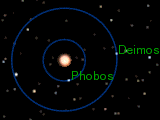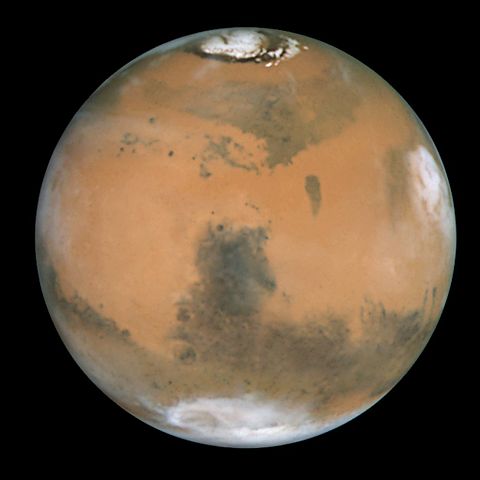
Phobos and Deimos orbiting Mars
The origin of Phobos and Deimos are still not well understood and debatable. Supporting the capture theory, the composition of the bodies have been comparatively similar to asteroids. However, some argue that the unstable orbit of Phobos points towards a relatively recent capture. Additionally, both moons have circular orbits near the equator, which is very unusual for captured objects. Other theories that have been raised deal with accretion early in the history of Mars and impact disruption in Mars’ early history which caused the formation of the moons from Mars itself.
Mars itself is the fourth planet from the Sun and the second smallest planet in the Solar System. It is named after the Roman god of war and often described as the “Red Planet”, as the iron oxide prevalent on its surface gives it a reddish appearance. The rotational period and seasonal cycles of Mars are similar to those of Earth, as is the tilt that produces the seasons; thus Mars has been a favorite in science fiction novels as a inhabitable planet or source of extraterrestrial life. Unfortunately, Mars is completely uninhabitable by humans. Mars falls 100 degrees below zero every night. Further, there is a lack of Oxygen; the air and even cloud formations are made up almost entirely of Carbon Dioxide.
The first successful Mars flyby was in 1965 by Mariner 4. The Mars rover Spirit and Phoenix lander were robotic explorers later sent to Mars. The Mars rover Spirit sampled chemical compounds containing water molecules in March 2007. The Phoenix lander directly sampled water ice in shallow Martian soil on July 31, 2008. Mars is currently host to five functioning spacecraft: three in orbit – the Mars Odyssey, Mars Express, and Mars Reconnaissance Orbiter; and two on the surface – Mars Exploration Rover Opportunity and the Mars Science Laboratory Curiosity.





 Twitter
Twitter LinkedIn
LinkedIn Youtube
Youtube RSS
RSS